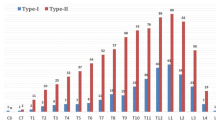Abstract
Purpose
Hemivertebrae is the most frequent reason of congenital scoliosis, and hemimetameric shift is a finding, which is characterized by two hemivertebraes located contralateral, with at least one normal vertebra between them. Embryologically, hemivertebrae is caused by delay in somite movements and as a result, a total vertebral shift occurs because of mismatches in the following segments. Hemimetameric shift accompanying spina bifida is described as extremely rare. There are only two case series of hemimetameric shift in literature but no spina bifida patient was reported in these series.
Methods
We report three cases of hemimetameric shift with spina bifida with their detailed clinical and radiological evaluations.
Results
Case 1 is a 3-year-old congenital scoliosis patient with tethered cord. She has mild scoliosis with a very demonstrative hemimetameric shift. Case 3 is an infant with multiple-level hemivertebrae anomalies and hemimetameric shift who had myelomeningocele closure and ventriculoperitoneal shunt installation neonatally. Case 3 is a 9-year-old male who had operated for myelomeningocele in the neonatal period. He had evident scoliosis with cervicothoracic hemimetameric shift and he is the only patient we operated for prominent scoliosis.
Conclusions
The present classification of hemimetameric shift was described by Kawakami et al. in 2009. It is based on development of anterior and posterior hemivertebrae segments but we think it is not suitable for patients with posterior fusion defects such as spina bifida patients. Spina bifida patients with scoliosis and hemimetameric shift are a rare but important patient group to evaluate in terms of understanding scoliosis patients with neural tube defects.





Similar content being viewed by others
References
Tsou PM, Yau A, Hodgson AR (1980) Embryogenesis and prenatal development of congenital vertebral anomalies and their classification. Clin Orthop Relat Res 211–231
Shawen SB, Belmont PJ Jr, Kuklo TR, Owens BD, Taylor KF, Kruse R, Polly DW Jr (2002) Hemimetameric segmental shift: a case series and review. Spine 27:E539–E544
Kawakami N, Tsuji T, Imagama S, Lenke LG, Puno RM, Kuklo TR, Spinal Deformity Study G (2009) Classification of congenital scoliosis and kyphosis: a new approach to the three-dimensional classification for progressive vertebral anomalies requiring operative treatment. Spine 34:1756–1765
Barnes E (2012) Atlas of developmental field anomalies of the human skeleton: a paleopathology perspective. John Wiley & Sons, Hoboken, NJ
Pang D, Thompson DN (2011) Embryology and bony malformations of the craniovertebral junction. Child’s Nervous System: ChNS: official journal of the International Society for Pediatric Neurosurgery 27:523–564
Ghita RA, Georgescu I, Muntean ML, Hamei S, Japie EM, Dughila C, Tiripa I (2015) Burnei-Gavriliu classification of congenital scoliosis. Journal of Medicine and Life 8:239–244
Saito T, Kawakami N, Tsuji T, Ohara T, Suzuki Y, Nohara A, Tauchi R, Kawakami K (2016) Three-dimensional analysis of hemimetameric segmental shift in congenital scoliosis. J Pediatr Orthop
Winter R (1983) Congenital deformities of the spine. Thieme-Stratton, New York
McMaster MJ, David CV (1986) Hemivertebra as a cause of scoliosis. A study of 104 patients. The Journal of Bone and Joint Surgery British Volume 68:588–595
Zhu X, Wei X, Chen J, Li C, Li M, Qiao Y, Ran B (2014) Posterior hemivertebra resection and monosegmental fusion in the treatment of congenital scoliosis. Ann R Coll Surg Engl 96:41–44
Author information
Authors and Affiliations
Corresponding author
Ethics declarations
Conflict of interest
None.
Rights and permissions
About this article
Cite this article
Canaz, H., Canaz, G., Ucar, B.Y. et al. Hemimetameric shift in spina bifida: three case reports. Childs Nerv Syst 33, 535–539 (2017). https://doi.org/10.1007/s00381-016-3292-y
Received:
Accepted:
Published:
Issue Date:
DOI: https://doi.org/10.1007/s00381-016-3292-y




